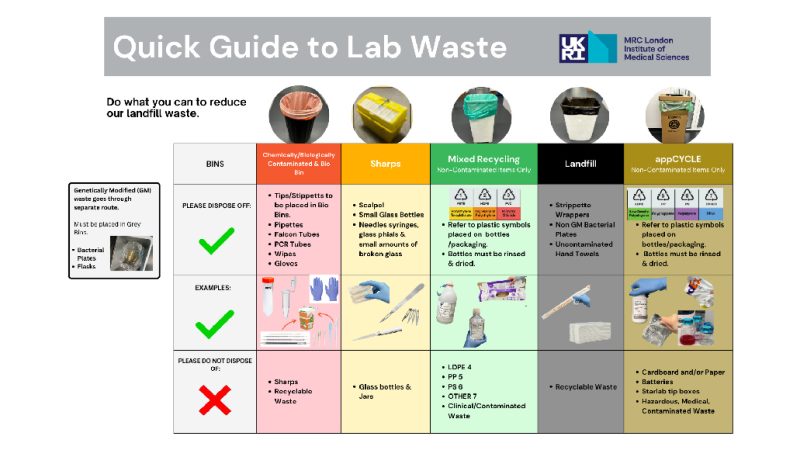Top Tips to Reduce Your Lab Waste
Home > News > Top Tips to Reduce Your Lab Waste
By LMS Staff Member
October 2, 2023
Time to read: 4 minutes
Labs are estimated to produce a shocking 2% of all global plastic waste. Biomedical labs alone send a staggering 5.5 million tonnes of plastic each year. Now more Than ever, it is essential for labs to make small changes to their practice to make a big difference.
The need for sterility and fear of contamination has resulted in scientists becoming heavily reliant on single-use plastic.
Using the tips below we can start to reduce the amount of plastic that we use, and learn how to better recycle the waste that we do produce:
1. Recycle your plastic bottles
Most media and PBS bottles are made of Pet1 plastic and can be recycled by the institute
- Check for the recycling number on bottles, and those which are Pet1/2 and do not contain toxic or contaminated waste can be recycled. Rinse, remove/ score out the label and put in a green bag for collection.
2. Use reusable glass bottles instead of single-use plastic
Previous generations of scientists didn’t have access to all the individually wrapped plastics we use today- instead, they used washed and autoclaved glassware.
- Pick up glass bottles from wash-up to use for preparing buffers/ reagents.
- Red lidded bottles have been autoclaved, blue lidded tubes have been washed with disinfectant. Only use autoclaved glassware if you think it is necessary for your experiment as autoclaves use a lot of energy and water to run.
3. Shop smart
Several greener alternatives exist for common lab products. For example:
- Starlab tip boxes can be recycled – just pop them in the blue wheely bin
- Choose suppliers who use less packaging. Companies like ThermoFisher send items in cardboard cool boxes rather than polystyrene, and consider using 2Bescientific, a carbon-neutral life sciences supplier, to buy your reagents from
- Some companies reuse their polystyrene packaging. Promega, NEB, BioLine Meridian and Insight Biotechnology provide return address labels with their packaging so all you need to do is take them down to the post room and they will be sent back and reused. Check out our poster for more details.
- Greening LMS have just set up a Cheminventory licence for all users at LMS – a chemical-sharing database that will help us share commonly used chemicals and reduce unnecessary orders
- We are working with the MRC head office to get ordering systems to prioritise greener lab products, in the meantime, check out mygreenlab and its great resources for lists of easy greener chemistry alternatives: https://www.mygreenlab.org/green-chemistry.html
4. Think about what pipette tips you use
Individually wrapped nuclease-free filter tips use a huge amount of plastic
- If you don’t need your experiment to be nuclease-free then use stackable tips instead of individually wrapped boxes of tips. These can be autoclaved for tissue culture use.
5. Use glass pipettes rather than plastic
Glass products take less CO2 to produce than plastic
- Greening LMS has received funding to buy reusable glass strippettes.
6. Reduce the amount of paper waste you produce
- Read papers online- or if you need to print it, then skip the reference list
- Pick recycled alternatives: recycled notebooks, printing paper and post-its are all available at the LMS.
7. Recycle!
- Along with the dry paper and card, Pet 1 and Pet 2 plastics can be recycled at the LMS.
- Check for the recycling signs before you put it in the bin.
- Most polystyrene boxes and ice packs can be returned to the sender.

Greening LMS News
Resources by Greening LMS
Resources from other Institutes
